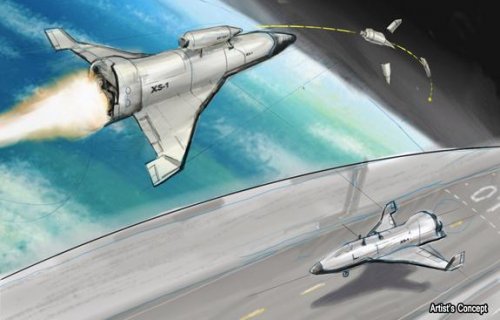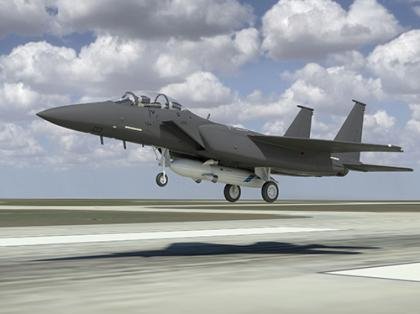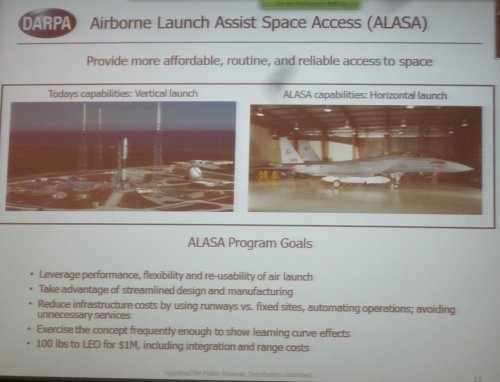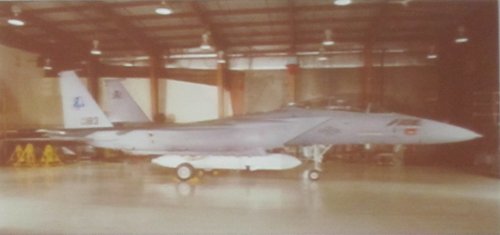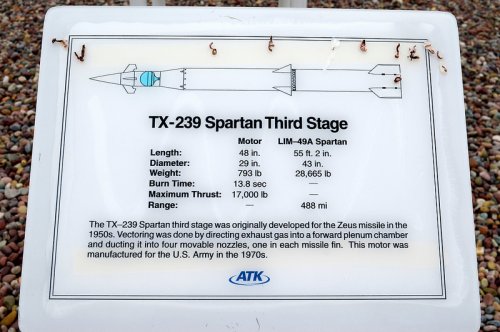You are using an out of date browser. It may not display this or other websites correctly.
You should upgrade or use an alternative browser.
You should upgrade or use an alternative browser.
DARPA Experimental Spaceplane (XS-1)
- Thread starter DSE
- Start date
XP67_Moonbat
ACCESS: Top Secret
- Joined
- 16 January 2008
- Messages
- 2,259
- Reaction score
- 459
- Joined
- 9 October 2009
- Messages
- 21,129
- Reaction score
- 12,216
FighterJock
ACCESS: Top Secret
- Joined
- 29 October 2007
- Messages
- 4,944
- Reaction score
- 4,740
A very cool find B) I wonder if it would see the light of day as flyable hardware and not just a paper exercise.
- Joined
- 3 June 2011
- Messages
- 17,871
- Reaction score
- 10,919
FighterJock said:A very cool find B) I wonder if it would see the light of day as flyable hardware and not just a paper exercise.
I'd put the odds somewhere between "hell no" and "BWAH HAH HAH HA". :'(
- Joined
- 3 June 2011
- Messages
- 17,871
- Reaction score
- 10,919
"The ultimate goal of the flight program is to address technical challenges and improve understanding of terminal phase performance of hypersonic flight vehicles."DSE said:sferrin said:FighterJock said:A very cool find B) I wonder if it would see the light of day as flyable hardware and not just a paper exercise.
I'd put the odds somewhere between "hell no" and "BWAH HAH HAH HA". :'(
DAMN, an optimist! How about this new RFI from the USAF Space and Missile Command in LA to Terminal Phase Experiments?
This leaves me wondering what happened to the information they got from Pershing II RVs? ???
On the subject of loosing data, there is an interesting cooment in BSP: Hupersonics, Ramjets and Missiles.
In his unpublished memoir on ramjet development at Bristol Aero Engines and BSEL, John Lane describes a series of papers he wrote with Robin Jamieson on air-breathing high-speed propulsion systems. Lane makes a very interesting statement: “The papers caused quite a stir when they came out and were ahead of the field. The work was trotted around the US by the author for Rolls Royce in the 1980’s. The author found that the US had not recorded their own work and had forgotten most of it.’
In his unpublished memoir on ramjet development at Bristol Aero Engines and BSEL, John Lane describes a series of papers he wrote with Robin Jamieson on air-breathing high-speed propulsion systems. Lane makes a very interesting statement: “The papers caused quite a stir when they came out and were ahead of the field. The work was trotted around the US by the author for Rolls Royce in the 1980’s. The author found that the US had not recorded their own work and had forgotten most of it.’
- Joined
- 26 September 2008
- Messages
- 1,935
- Reaction score
- 679
sferrin said:FighterJock said:A very cool find B) I wonder if it would see the light of day as flyable hardware and not just a paper exercise.
I'd put the odds somewhere between "hell no" and "BWAH HAH HAH HA". :'(
They may develop some hardware. Whether it ultimately flies or not is another question. This is pretty ambitious. Many DARPA projects are ambitious, but many DARPA projects die early on. Although DARPA has this popular image as a miracle factory, the reality is that much of what they try fails. You expect that in cutting edge R&D, but I have talked to a few very knowledgeable people who actually think that DARPA pursues too many high risk projects and really should dial it back. I think that's an argument that resurfaces in the R&D community and DARPA at least once a decade.
- Joined
- 26 September 2008
- Messages
- 1,935
- Reaction score
- 679
sferrin said:This leaves me wondering what happened to the information they got from Pershing II RVs?
There's lots of data. But there's lots of different kinds of data to gather too. There is all kinds of hypersonic research, from how to control a hypersonic vehicle in flight (which you can do by firing an HV on a rocket and then letting it glide at hypersonic speeds, like they did with the HVX-2) to the major challenge, which is an air-breathing hypersonic engine.
I haven't looked closely at DARPA's XS-1 program, but off the top of my head my guess is that gathering hypersonic data is just a box that they checked to get that community on board. It is common with research proposals (for instance, when people are asking for money) to claim that your project will not only reveal the secrets of the universe, but will also cure cancer and work well as a floor polish. So my guess is that they looked at the regime that this thing will operate in and said "Hey, let's try and get the support of the hypersonics people too, because it will fly hypersonically."
The U.S. made substantial progress on hypersonics in the past decade or so, but there are still some big gaps in the data. There is no concerted U.S. hypersonics research program right now (it has sort of fallen through the cracks), but at least China is still going strong!
US Military's XS-1 Space Plane Project Seeks $27 Million in 2015 Funding
The U.S. Defense Advanced Research Projects Agency expects to spend some $800 million on space programs from 2015 through 2018, an increase of $130 million over what was projected at this time last year, Defense Department budget documents show.
Nearly all of the targeted increase for DARPA's Space Programs and Technology Office is backloaded into the outyears, the documents show. For 2015, the office is seeking nearly $180 million, only $7.5 million more than this year’s funding level.
airrocket
Dreams To Reality
So what company won its been several weeks past the submit date????
IIRC, *four* companies were to win Phase A contracts. I don't think winners have been announced yet.
airrocket said:So what company won its been several weeks past the submit date? ???
Parabolic Arc: DARPA Moves Forward With Phoenix, ALASA and XS-1 Projects
No players yet, but shows requested FY15 $$.
- Joined
- 21 April 2009
- Messages
- 13,551
- Reaction score
- 7,153
blackstar said:ALASA
Not to jump topics but could ALASA be a strike weapon or a tail chase ABM
blackstar said:ALASA
Boeing: Boeing wins contract to design DARPA Airborne Satellite Launch Vehicle
Boeing’s design takes the concept one step further and shifts traditional thinking when it comes to today’s launch vehicles.
“As these stages are jettisoned (or dropped), the fuel tank and engines are just thrown away. We developed a cost-effective design by moving the engines forward on the launch vehicle. With our design, the first and second stages are powered by the same engines, reducing weight and complexity,” explained Steve Johnston, director, Advanced Space Exploration.
Having a hard time wrapping my head around how this might be accomplished, but then again it is Monday.
Also, isn't the F-15 the first stage?
- Joined
- 26 September 2008
- Messages
- 1,935
- Reaction score
- 679
bobbymike said:blackstar said:ALASA
Not to jump topics but could ALASA be a strike weapon or a tail chase ABM
Why would it be either of those things? If you want a strike weapon, you design a strike weapon. No need to go through all this trouble to say that you're designing a small satellite launcher and then do something else with it.
And under what scenario would a "tail chase" ABM work? If you're behind the missile you want to shoot down, then you're over the bad guy's territory. Why would you be there? And if you were there, why wouldn't you just be shooting at the missile on the ground?
There's a lot of interest in really small satellites lately. They are usually launched in multiples atop bigger rockets, almost always as ride-along secondary payloads. That makes their launch relatively cheap, but it also puts the secondary at the mercy of the main payload. So for awhile now people have been talking about developing cheap ways to launch small satellites one at a time. ALASA is one effort to do that. We can have our doubts, because for starters an F-15 is not a cheap aircraft to operate. And if you only have one, you have to spread out your cost across all your launches. Thus, if it only launches once a month, you have to charge the entire month's cost to that launch. (And if it only launches once a year, you charge the entire year's cost.)
We'll see if they can make it work. Remember that DARPA is often about trying stuff to see if the technology can work, but it does not have to turn into something that is useful in the end. People remember DARPA's successes, but are often unaware that they fail a lot. DARPA fails a lot at what it tries to do. (Let's repeat that: DARPA fails a lot at what it tries to do.)
- Joined
- 21 April 2009
- Messages
- 13,551
- Reaction score
- 7,153
When I say 'tail chase' I just mean boost phase interception with a missile I believe the concept has been studied in various configurations with a very fast burn missile. I have just read that referred to as chasing a missiles tail, sorry if I was unclear in my post.
..............The BPI Phase I ACTD evaluated the affordability and assessed the operational utility and mission effectiveness of BPI engagements. The BPI ACTD technical approach employed a high speed tactical missile with a kinetic kill vehicle carried on an airbreathing platform such as the F-14 or F-15. The missile was capable of velocities in excess of 3 km/s and a range of 120 km, and was designed to be a precursor to an objective system with a 5.5 km/s velocity and a 250 km range. On-board and off-board sensors were used to detect, track, and provide in-flight updates. The BPI Phase I was completed in fourth quarter FY95............
http://scienceandglobalsecurity.org/archive/sgs12wilkening.pdf
As for weaponization something that could put a 100kg payload in orbit can put a 100kg warhead 'next' to something in orbit or if it in going from air to ground probably a larger warhead for A2G.
..............The BPI Phase I ACTD evaluated the affordability and assessed the operational utility and mission effectiveness of BPI engagements. The BPI ACTD technical approach employed a high speed tactical missile with a kinetic kill vehicle carried on an airbreathing platform such as the F-14 or F-15. The missile was capable of velocities in excess of 3 km/s and a range of 120 km, and was designed to be a precursor to an objective system with a 5.5 km/s velocity and a 250 km range. On-board and off-board sensors were used to detect, track, and provide in-flight updates. The BPI Phase I was completed in fourth quarter FY95............
http://scienceandglobalsecurity.org/archive/sgs12wilkening.pdf
As for weaponization something that could put a 100kg payload in orbit can put a 100kg warhead 'next' to something in orbit or if it in going from air to ground probably a larger warhead for A2G.
- Joined
- 26 September 2008
- Messages
- 1,935
- Reaction score
- 679
bobbymike said:When I say 'tail chase' I just mean boost phase interception with a missile I believe the concept has been studied in various configurations with a very fast burn missile. I have just read that referred to as chasing a missiles tail, sorry if I was unclear in my post.
..............The BPI Phase I ACTD evaluated the affordability and assessed the operational utility and mission effectiveness of BPI engagements. The BPI ACTD technical approach employed a high speed tactical missile with a kinetic kill vehicle carried on an airbreathing platform such as the F-14 or F-15. The missile was capable of velocities in excess of 3 km/s and a range of 120 km, and was designed to be a precursor to an objective system with a 5.5 km/s velocity and a 250 km range. On-board and off-board sensors were used to detect, track, and provide in-flight updates. The BPI Phase I was completed in fourth quarter FY95............
http://scienceandglobalsecurity.org/archive/sgs12wilkening.pdf
As for weaponization something that could put a 100kg payload in orbit can put a 100kg warhead 'next' to something in orbit or if it in going from air to ground probably a larger warhead for A2G.
And if you're going to do either of those things, why not just do those things? Why do this instead?
There's lots of problems/issues with the things you mention. BPI, for instance, requires that you be relatively close to the launch site. It also requires really good tracking. There has been some discussion of doing that with F-15 type launches (the Israelis were interested a few years ago). Problem is that you'd have to put a lot of interceptors up. And you'd have to have good intel and tracking. Tough thing to do.
USAF is not in favor of kinetic kill ASATs. They don't want to create a lot of debris that might end up destroying their own satellites.
So, no. This is not for doing that. This is for doing what they say it is for.
- Joined
- 21 April 2009
- Messages
- 13,551
- Reaction score
- 7,153
Sorry did I imply this is what the program was for or simply ask if the booster/payload combo could be used for those alternate purposes? Like using an ATACMS for the X-51 test. I'm sure when the first ATACMS was shown at ground launch if someone would have asked, 'Hey can you put one of those on a B-52 external pylon for hypersonics research"? Would have gotten the same response you just gave me.blackstar said:bobbymike said:When I say 'tail chase' I just mean boost phase interception with a missile I believe the concept has been studied in various configurations with a very fast burn missile. I have just read that referred to as chasing a missiles tail, sorry if I was unclear in my post.
..............The BPI Phase I ACTD evaluated the affordability and assessed the operational utility and mission effectiveness of BPI engagements. The BPI ACTD technical approach employed a high speed tactical missile with a kinetic kill vehicle carried on an airbreathing platform such as the F-14 or F-15. The missile was capable of velocities in excess of 3 km/s and a range of 120 km, and was designed to be a precursor to an objective system with a 5.5 km/s velocity and a 250 km range. On-board and off-board sensors were used to detect, track, and provide in-flight updates. The BPI Phase I was completed in fourth quarter FY95............
http://scienceandglobalsecurity.org/archive/sgs12wilkening.pdf
As for weaponization something that could put a 100kg payload in orbit can put a 100kg warhead 'next' to something in orbit or if it in going from air to ground probably a larger warhead for A2G.
And if you're going to do either of those things, why not just do those things? Why do this instead?
There's lots of problems/issues with the things you mention. BPI, for instance, requires that you be relatively close to the launch site. It also requires really good tracking. There has been some discussion of doing that with F-15 type launches (the Israelis were interested a few years ago). Problem is that you'd have to put a lot of interceptors up. And you'd have to have good intel and tracking. Tough thing to do.
USAF is not in favor of kinetic kill ASATs. They don't want to create a lot of debris that might end up destroying their own satellites.
So, no. This is not for doing that. This is for doing what they say it is for.
- Joined
- 26 September 2008
- Messages
- 1,935
- Reaction score
- 679
bobbymike said:Sorry did I imply this is what the program was for or simply ask if the booster/payload combo could be used for those alternate purposes?
That rocket could also be used to cook steaks. It's not ideal for that, mind you, but fire is fire, right?
Boost phase intercept requires really high acceleration to go catch a missile from behind. Satellite launchers tend to not have really high acceleration.
- Joined
- 21 April 2009
- Messages
- 13,551
- Reaction score
- 7,153
blackstar said:bobbymike said:Sorry did I imply this is what the program was for or simply ask if the booster/payload combo could be used for those alternate purposes?
That rocket could also be used to cook steaks. It's not ideal for that, mind you, but fire is fire, right?
Boost phase intercept requires really high acceleration to go catch a missile from behind. Satellite launchers tend to not have really high acceleration.
Mmmm - rocket steaks
- Joined
- 21 April 2009
- Messages
- 13,551
- Reaction score
- 7,153
Yes very interesting a nosecone divert system prior to payload release of mini-sat?blackstar said:Scroll back up and look at the ALASA image.
Notice that the rocket appears to have its engine nozzles near the top. Interesting, no?
- Joined
- 26 September 2008
- Messages
- 1,935
- Reaction score
- 679
bobbymike said:Yes very interesting a nosecone divert system prior to payload release of mini-sat?blackstar said:Scroll back up and look at the ALASA image.
Notice that the rocket appears to have its engine nozzles near the top. Interesting, no?
Those are the rocket engine nozzles.
- Joined
- 16 April 2008
- Messages
- 9,010
- Reaction score
- 12,687
So it's got a tractor configuration, with the fuel tanks for the first stage below the rocket engines. The first stage pumps fuel up the stack to the engines, then drops the tank when it's empty.
- Joined
- 26 September 2008
- Messages
- 1,935
- Reaction score
- 679
TomS said:So it's got a tractor configuration, with the fuel tanks for the first stage below the rocket engines. The first stage pumps fuel up the stack to the engines, then drops the tank when it's empty.
Yeah, and the question is why? What advantage is this configuration? One guess is that they have a two-stage configuration, but keep the engines, only dropping a tank.
- Joined
- 3 June 2011
- Messages
- 17,871
- Reaction score
- 10,919
TomS said:Yep, that's exactly what they say -- they have two stages but only one set of engines, which saves weight.
Seems sensible, but there must be disadvantages or we'd have seen it more often.
Can you imagine a circle of F-1s around the Apollo command module?
TomS said:Seems sensible, but there must be disadvantages or we'd have seen it more often.
Off the top of my head, I'd say there are some problems:
- The exhaust will scorch the lower fuel tank.
- Cosine losses because the engines have to point slightly sideways.
- The rockets have to be powerful enough to lift the lower tank, which means they are too powerful for the upper stage.
However, every launch scenario is different and has different optimizations, so the tractor method might actually work well here.
- Joined
- 3 June 2011
- Messages
- 17,871
- Reaction score
- 10,919
antiquark said:However, every launch scenario is different and has different optimizations, so the tractor method might actually work well here.
- The rockets have to be powerful enough to lift the lower tank, which means they are too powerful for the upper stage.
But they're the same as you'd need for a lower stage and it means you don't need to carry the added weight of an upper stage propulsion system (of course you're having to accelerate that larger propulsion system to a higher velocity). OTH your thrust-vector lines aren't optimal as you mentioned. OTOOH you should be able to have a lighter structure with it not being in compression from the get-go. Have there been many other tractor systems other than the Zeus B & Spartan 3rd stages? ???
sferrin said:Have there been many other tractor systems other than the Zeus B & Spartan 3rd stages? ???
I haven't heard of any. Actually I think the biggest problem would be the 5000 degree flames licking down the sides of the tanks. Not an easy problem to ignore, IMHO!
- Joined
- 16 April 2008
- Messages
- 9,010
- Reaction score
- 12,687
You do see the configuration in things like the TOW missile (the sustainer motor exhausts midway along the missile body, to keep the tail clear for the wire reel and the tracking flare). But yeah, not a lot of other space launch applications.
This tractor rocket configuration was also - kinda - used on the Spartan ABM. The Thiokol TX-239 was a spherical "gas generator," with the exhaust ducted forward and out through for rocket nozzles, each in the trailing edges of the forward fins. Moving the fins vectored the nozzles. I imagine this was thought to simplify the control system, at the expense of weight and some pretty harsh environments for the duct work and rotary joints.
Not sure that's what they're going for with ALASA, but there it is.
Note: I think the illustration below has the gas generator in backwards.
Not sure that's what they're going for with ALASA, but there it is.
Note: I think the illustration below has the gas generator in backwards.
Attachments
- Joined
- 16 April 2008
- Messages
- 9,010
- Reaction score
- 12,687
DSE said:And the TOW fires for how long and with how many stages?TomS said:You do see the configuration in things like the TOW missile (the sustainer motor exhausts midway along the missile body, to keep the tail clear for the wire reel and the tracking flare). But yeah, not a lot of other space launch applications.
Please notice that I specifically pointed out that this was not a comparable application.
Similar threads
-
Early Artist Drawing to a Hypothetical Bell XS-1 in 1946 (very different)
- Started by hesham
- Replies: 1
-
DARPA to develop microscale navigational gyro for guided munitions and hand-held
- Started by seruriermarshal
- Replies: 1
-
-
-

